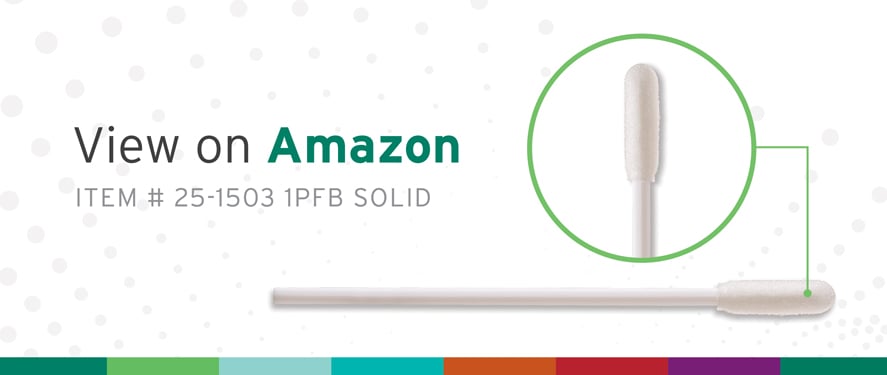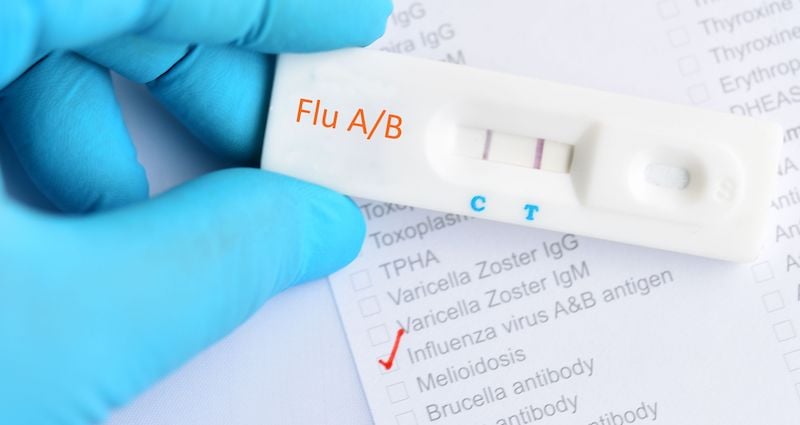
During the 2023-2024 flu season, the CDC estimates that nearly 45,000 people died from the flu. While it’s too soon to tell what the upcoming flu season will hold, it’s likely that cases will continue to increase over the winter and into spring. The CDC predicts that influenza rates will likely be similar to last season.
But that’s not the only virus people need to pay attention to.
The increase in COVID-19 cases has added another layer of complexity to the historically peak seasonal illness time of year. COVID and the flu share a number of similar symptoms, which will make diagnostic testing particularly important this flu season.
So, with this in mind, what should clinicians expect?
They should anticipate increased testing rates to guide decisions on initiating antiviral treatments, conducting additional diagnostic tests, or implementing infection prevention and control measures for influenza.
Getting a fast, accurate diagnosis will help in driving these care decisions, but speed and accuracy will vary based on the type of test performed and testing materials used.
Flu Trends for 2024-2025
As mentioned before, the CDC expects this flu season to be similar to the previous year. Hospitalizations will likely be the same or slightly lower, but things could change depending on how many people get routine vaccinations, isolate at home, and seek medical care when they aren’t feeling well.
With the newest flu vaccines hitting the market this fall, they aim to reduce the severity of illness by targeting the most likely strains expected to spread throughout the country. The FDA’s Vaccines and Related Biological Products Advisory Committee (VRBPAC) has recommended a trivalent formulation for this year’s egg-based and cell- or recombinant-based vaccines, targeting three specific strain types:
-
H1N1
-
H3N2
-
B/Victoria lineage
If vaccination rates are high, the flu season will likely be less severe. However, if people avoid the vaccine or delay getting vaccinated, we will likely see the opposite.
The Types of Flu Swab Tests
There are several types of flu tests available, each with varying degrees of speed and accuracy. Some tests may be better suited for children, elderly, or sensitive patients, so it’s important to understand your options. Below are the most common flu tests.
1. Rapid Influenza Diagnostic Tests (RIDTs)
The most commonly used flu tests, RIDTs, work by detecting the viral antigens that stimulate a person’s immune response. These tests are easy to use and can provide results within approximately 15 minutes.
2. RT-PCR, Rapid Molecular, and Nucleic Acid Amplification Assays
Reverse Transcription-Polymerase Chain Reaction (RT-PCR), rapid molecular tests, and nucleic acid amplification assays detect the genetic material of the flu virus. RT-PCR tests may take a few days, while rapid molecular and nucleic acid amplification tests can produce results in as little as 20 minutes. These tests are commonly used to identify the influenza virus in populations suffering from acute respiratory outbreaks, such as hospitals, elder-care facilities, long-term care facilities, and the like.
3. Viral Cell Culture Test
Viral cell culture tests perform an extremely accurate and conclusive method for diagnosing influenza. Viral cell culture tests can determine the strain of virus and have become the most common test to help identify and track the spread of flu. However, results for these tests generally take 24 to 48 hours—or longer—as they must be sent to a lab. Some cultures may take up to 10 days. As a result, these tests are a better option for population health support, such as documenting the specific strains of influenza active in a given population or region or tracking the effectiveness of antiviral agents. Viral cell cultures can also be used to confirm or refute a rapid flu test result.
With unmatched expertise for over 45 years, Puritan Medical Products is your trusted partner for tailor-made medical swabs and kits for flu testing. Explore our comprehensive solutions and experience excellence.
How to Swab for the Flu
As a healthcare professional, you know that there is a proper way to swab for the flu that will ensure more accurate results. The use of high-quality products—including appropriate swabs, transport media, and test kits—can help accurately diagnose influenza and reduce the potential spread of the virus.
Flu tests can be performed using nasopharynx (NP) swabs, throat swabs, NP or bronchial washes, nasal or endotracheal aspirate, or sputum testing.
To perform an NP flu swab test, follow these steps:
-
Choose a swab with a flexible plastic handle and flock tip, such as Puritan’s PurFlock Ultra 6" Sterile Ultrafine Flock Swab w/Polystyrene Handle.
-
Insert the swab into one nostril straight back (not upwards) and horizontally to the nasopharynx up to the molded breakpoint.
-
Rotate the swab up to 5 times and hold it in place for 5 to 10 seconds to collect sample material.
-
Remove the swab and insert it into a vial containing 1 to 3 ml of viral transport media.
-
Break the swab handle at the scored breakpoint line.
-
Label the vial with appropriate patient information.
Want some extra help? Check out our video guide for nasopharyngeal swabbing.
Note: Sample collection should be followed according to the manufacturer's product insert if using a swab provided in a diagnostic kit.

Want to take these steps with you or post them in your office to ease patient worries around testing? Download our printable PDF here.
After all, we all heard about the brain touching swab rumor a few years ago – it’s good to remind patients that swabbing your brain is not in the cards for their visit.
What is a flu swab test?
A flu swab test is one of several options available for diagnosing influenza viruses in nasal, nasopharyngeal or throat specimens. Each of these tests requires that a healthcare provider rotate the inside of the patient’s nose, nasopharynx or the back of the individual’s throat with a swab, then store and transport the swab according to the test type procedure for analysis.
These tests may vary in their effectiveness due to a number of reasons, including the number of flu variants circulating and the type of testing methodology and materials used. To ensure the most accurate possible results, it is important to select your flu test swab with care.
How to Choose Your Flu Swab
Clinicians have several options in swabs when it comes to performing a flu swab test, but not every swab will generate the same level of accuracy. For maximum specimen access, swabs should be transported using appropriate transport media.
Swab options for flu testing include flocked swabs, rayon tipped swabs, and foam tipped swabs.
1. Flocked Swabs
The American Society for Microbiology (ASM) recommends flocked swabs as the preferred specimen collection device for flu testing. In fact, flocked swabs have been hailed by the microbiology and diagnostic communities for their ability to absorb and elute more specimen than traditional spun fiber or foam swabs.
2. Rayon and Polyester Tipped Swabs
Like the cotton swabs, rayon tipped swabs are made from spun fiber. This fiber is synthetic, low cost, soft and absorbent, and can be used for many applications where cotton would not be suitable, such as for diagnostic specimen collection.
While not quite as efficient as the flocked swab, the rayon swab fiber is produced from wood pulp through a denaturing process that eliminates any natural materials that may damage the specimen or interfere with specimen processing.
Polyester tipped swabs are the next step up when it comes to specimen collection. They have excellent collection properties and boast superior release properties. Polyester fiber has been tested and validated for use in specimen collection in microbiology, rapid diagnostic tests and PCR analysis.
4. Foam-Tipped Swabs
Medical grade polyurethane foam is also used as a tip material for diagnostics. The advantage of using a foam-tipped swab is that this tip type comes in various tip shapes, sizes and porosities, so your intended use dictates which foam-tipped swabs will work best.
All of these swab options are offered in sterile, individually wrapped peel pouches or in dry transport tubes.
5. Polyester Swabs
Polyester swabs are widely used in diagnostic testing due to their versatility and reliability. These swabs are ideal for specimen collection, especially for applications like DNA testing, throat swabs, and gynecological screenings. With a semi-flexible plastic handle and a durable polyester tip, they ensure consistent sample collection without compromising the specimen’s integrity. Additionally, each swab is individually wrapped to maintain sterility, making them a trusted choice for sensitive testing environments. Made in the USA, these swabs offer a dependable solution for healthcare and laboratory professionals.
Flu Swab Collection Tips
Knowing how to perform flu swab tests is just the first step in the process. You’ll also want to make the experience as comfortable and pleasant for the patient as possible while still ensuring that they get the results they need quickly. Here are a few tips to keep in mind.
-
Keep a variety of swabs on hand. Some swabs may work better than others for different patients. Consider keeping several types of swabs on hand so you can better tailor their test to their needs.
-
Be gentle when possible. The tests can be uncomfortable for adults who aren’t feeling their best and kids who may have never experienced a flu swab before. Be mindful of your patients’ comfort as you work. Use only gentle pressure when swabbing and work quickly to minimize their discomfort.
-
Consider distracting young patients. Young children can be difficult to test, so consider keeping toys, bright stickers, or other distractions on hand. You may also want to enlist their parent or guardian’s help when performing the test to ensure that the child doesn’t hurt themselves as you work.
-
Ask patients to blow their noses. It’s typically easier to perform a nasal or nasopharyngeal swab when the nasal cavity is clear of excess mucus. Ask adults and older children to blow their noses before you swab. If you’re testing a young child, wipe away the excess with a soft cotton swab.
-
Implement a specimen collection system. Flu season can be a busy time, and you’re likely to test dozens of patients each week during the peak. Consider implementing a complete specimen collection and transportation system into your practice instead of simply ordering sterile swabs. Puritan offers collection and transportation systems that will meet your needs.
Stock up for Flu Swab Tests
With flu season underway, it’s crucial for clinics, hospitals, and diagnostic labs around the world to keep in stock the highest quality specimen-collection products available. After all, the best defense is a good offense. As healthcare professionals know, the best way to help prevent the spread of the flu is with accurate, fast diagnosis and immediate treatment.
For additional insight on performing a flu swab test, download our infographic.
To learn more about how Puritan products can help you meet your flu testing needs, please contact us today.






